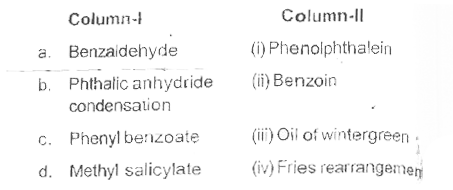Match the compounds given in Column I with their uses mentioned in Column II.
ColumnIColumnIIA.CaCO31.Densitry ornamental workB.Ca(OH)22.Manufacture of sodium carbonate from caustic sodaC.CaO3.Manufacure of high quality paperD.CaSO44.Used in white washing
The correct Answer is:A. →(3) B. →(4) C. →(2) D. →(1)
To solve the problem of matching the compounds in Column I with their respective uses in Column II, we will analyze each compound one by one.
1. Identify Compound A: CaCO₃ (Calcium Carbonate)
- Calcium carbonate is commonly used in the manufacture of high-quality paper.
- Match: A (CaCO₃) → 3 ("Manufacture of high quality paper")
2. Identify Compound B: Ca(OH)₂ (Calcium Hydroxide)
- Calcium hydroxide is widely used for whitewashing.
- Match: B (Ca(OH)₂) → 4 ("Used in white washing")
3. Identify Compound C: CaO (Calcium Oxide)
- Calcium oxide is used in the manufacture of sodium carbonate from caustic soda.
- Match: C (CaO) → 2 ("Manufacture of sodium carbonate from caustic soda")
4. Identify Compound D: CaSO₄ (Calcium Sulfate)
- Calcium sulfate is known as gypsum when hydrated and is used in dentistry for making molds and casts.
- Match: D (CaSO₄) → 1 ("Densitry ornamental work")
Final Matching:
- A (CaCO₃) → 3 ("Manufacture of high quality paper")
- B (Ca(OH)₂) → 4 ("Used in white washing")
- C (CaO) → 2 ("Manufacture of sodium carbonate from caustic soda")
- D (CaSO₄) → 1 ("Densitry ornamental work")
Summary of Matches:
- A → 3
- B → 4
- C → 2
- D → 1
- Calcium carbonate is commonly used in the manufacture of high-quality paper.
- Match: A (CaCO₃) → 3 ("Manufacture of high quality paper")
- Calcium hydroxide is widely used for whitewashing.
- Match: B (Ca(OH)₂) → 4 ("Used in white washing")
- Calcium oxide is used in the manufacture of sodium carbonate from caustic soda.
- Match: C (CaO) → 2 ("Manufacture of sodium carbonate from caustic soda")
- Calcium sulfate is known as gypsum when hydrated and is used in dentistry for making molds and casts.
- Match: D (CaSO₄) → 1 ("Densitry ornamental work")
- A (CaCO₃) → 3 ("Manufacture of high quality paper")
- B (Ca(OH)₂) → 4 ("Used in white washing")
- C (CaO) → 2 ("Manufacture of sodium carbonate from caustic soda")
- D (CaSO₄) → 1 ("Densitry ornamental work")
- A → 3
- B → 4
- C → 2
- D → 1
Topper's Solved these Questions
- THE S-BLOCK ELEMENTS BOOK - NCERT EXEMPLAR ENGLISHCHAPTER - THE S-BLOCK ELEMENTS EXERCISE - Assertion and Reason
2 Videos
- THE S-BLOCK ELEMENTS BOOK - NCERT EXEMPLAR ENGLISHCHAPTER - THE S-BLOCK ELEMENTS EXERCISE - Long Answer Type Questions
8 Videos
- THE S-BLOCK ELEMENTS BOOK - NCERT EXEMPLAR ENGLISHCHAPTER - THE S-BLOCK ELEMENTS EXERCISE - Short Answer Type Questions
11 Videos
- THE P-BLOCK ELEMENTSBOOK - NCERT EXEMPLAR ENGLISHCHAPTER - THE P-BLOCK ELEMENTSEXERCISE - Long Answer
9 Videos
- THERMODYNAMICSBOOK - NCERT EXEMPLAR ENGLISHCHAPTER - THERMODYNAMICSEXERCISE - Multiple choice questions
62 Videos
Similar Questions
Knowledge Check
Match the compounds given in column I with oxidation states of carbon given in column II and mark the appropriate choice.
Column IColumn II(A)C6H12O6 (i) +3(B)CHCl3 (ii) -3(C)CH3CH3 (iii) +2(D)(COOH)2 (iv) 0A(A) → (iv), (B) → (iii), (C) → (ii), (D) → (i)B(A) → (i), (B) → (ii), (C) → (iii), (D) → (iv)C(A) → (ii), (B) → (iii), (C) → (iv), (D) → (i)D(A) → (iii), (B) → (ii), (C) → (i), (D) → (iv)
Match the items given in Column 1 with examples give in Column II.
Column IColumn II(a)Hydrogen bond(i)C(b)Resonance(ii)LiF(c)Ionic solid(iii)H2(d)Covalent solid(iv)HF(v)O3
View SolutionMatch the species given in Column I with properties given in Column II
Column-IColumn-IIA.Diborane1.Used as a flux for soldering metalsB.Gallium2.Crystalline form of silicaC.Borax3.Banana bondsD.Aluminossilicate4.Low melting, high boiling, useful for measuring high temperaturesE.Quartz5.Used as catalyst in petrochemical industries
View SolutionMatch the types of colloidal systems given in Column I with the name given in Column II.
Column IColumn IIA.Solid in liquid1.FoamB.Liquid in solid 2.SolC.Liquid in liquid 3.GelD.Gas in liquid4.Emulsion
View SolutionMatch the shape of molecules in Column 1 with the type of hybridisation in Column II.
Column IColumn II(a)Tetrahedral(i)sp2(b)Trigonal(ii)sp(c)Linear(iii)sp3(d)Trigonal bipyramidal(iv)sp3d
View SolutionMatch the elements given in column (I) with the most appropriate expected values given in column (II)
Column IColumn IIElementElectronegative valuesA.F(p)3.5B.O(q)3.0C.N(r)4.0D.C(s)2.5
View SolutionMatch the Xenon compounds Column-I with its structure in Column-II and assign the correct code :
Column-IColumn-II(a)XeF4(i)pyramidal(b)XeF6(ii) square planar(c)XeOF4(iii) distored octahedral(d)XeO3(iv) square pyramidal
View SolutionMatch the important chemical given in column (A) with the chemical fomulae given in Column (B).
Column (A), Column (B)(a) Plaster of paris, (i)Ca(OH)2(b) Gypsum (ii)CaSO4.12H2O(c) bleaching powder (iii)CaSO4.2H2O(d) Slaked lime (iv)CaOCl2
View Solution


